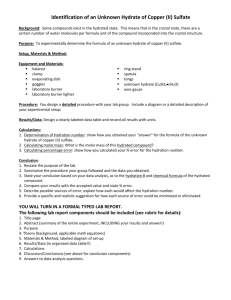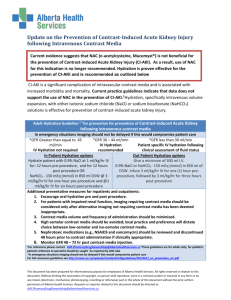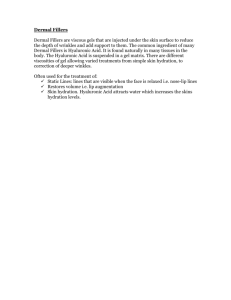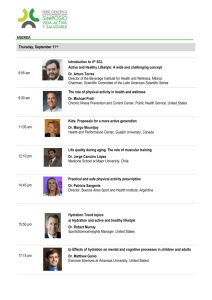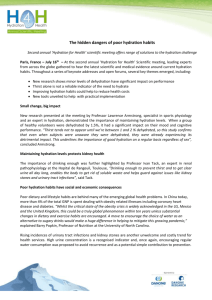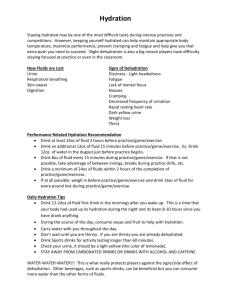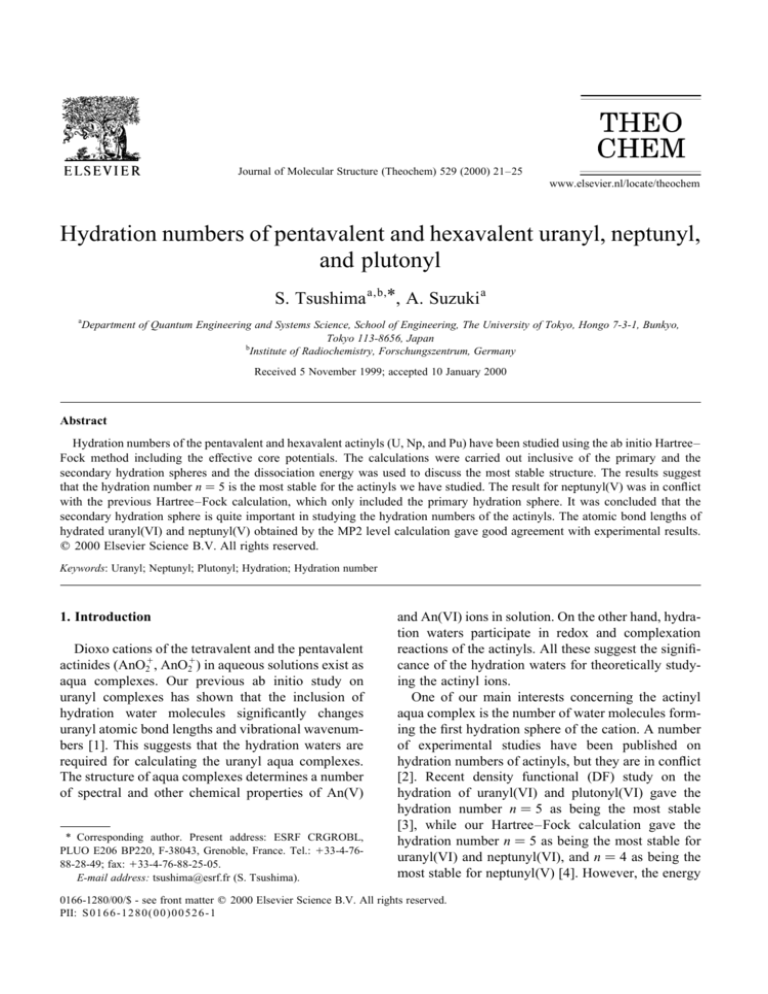
Journal of Molecular Structure (Theochem) 529 (2000) 21–25
www.elsevier.nl/locate/theochem
Hydration numbers of pentavalent and hexavalent uranyl, neptunyl,
and plutonyl
S. Tsushima a,b,*, A. Suzuki a
a
Department of Quantum Engineering and Systems Science, School of Engineering, The University of Tokyo, Hongo 7-3-1, Bunkyo,
Tokyo 113-8656, Japan
b
Institute of Radiochemistry, Forschungszentrum, Germany
Received 5 November 1999; accepted 10 January 2000
Abstract
Hydration numbers of the pentavalent and hexavalent actinyls (U, Np, and Pu) have been studied using the ab initio Hartree–
Fock method including the effective core potentials. The calculations were carried out inclusive of the primary and the
secondary hydration spheres and the dissociation energy was used to discuss the most stable structure. The results suggest
that the hydration number n 5 is the most stable for the actinyls we have studied. The result for neptunyl(V) was in conflict
with the previous Hartree–Fock calculation, which only included the primary hydration sphere. It was concluded that the
secondary hydration sphere is quite important in studying the hydration numbers of the actinyls. The atomic bond lengths of
hydrated uranyl(VI) and neptunyl(V) obtained by the MP2 level calculation gave good agreement with experimental results.
䉷 2000 Elsevier Science B.V. All rights reserved.
Keywords: Uranyl; Neptunyl; Plutonyl; Hydration; Hydration number
1. Introduction
Dioxo cations of the tetravalent and the pentavalent
actinides (AnO2⫹, AnO2⫹) in aqueous solutions exist as
aqua complexes. Our previous ab initio study on
uranyl complexes has shown that the inclusion of
hydration water molecules significantly changes
uranyl atomic bond lengths and vibrational wavenumbers [1]. This suggests that the hydration waters are
required for calculating the uranyl aqua complexes.
The structure of aqua complexes determines a number
of spectral and other chemical properties of An(V)
* Corresponding author. Present address: ESRF CRGROBL,
PLUO E206 BP220, F-38043, Grenoble, France. Tel.: ⫹33-4-7688-28-49; fax: ⫹33-4-76-88-25-05.
E-mail address: tsushima@esrf.fr (S. Tsushima).
and An(VI) ions in solution. On the other hand, hydration waters participate in redox and complexation
reactions of the actinyls. All these suggest the significance of the hydration waters for theoretically studying the actinyl ions.
One of our main interests concerning the actinyl
aqua complex is the number of water molecules forming the first hydration sphere of the cation. A number
of experimental studies have been published on
hydration numbers of actinyls, but they are in conflict
[2]. Recent density functional (DF) study on the
hydration of uranyl(VI) and plutonyl(VI) gave the
hydration number n 5 as being the most stable
[3], while our Hartree–Fock calculation gave the
hydration number n 5 as being the most stable for
uranyl(VI) and neptunyl(VI), and n 4 as being the
most stable for neptunyl(V) [4]. However, the energy
0166-1280/00/$ - see front matter 䉷 2000 Elsevier Science B.V. All rights reserved.
PII: S0166-128 0(00)00526-1
22
S. Tsushima, A. Suzuki / Journal of Molecular Structure (Theochem) 529 (2000) 21–25
hydration spheres. The effect of apical water molecules bonding to the axial oxygen of the actinyls
was also studied.
2. Theoretical methodology
Fig. 1. Structure of actinyl with the primary and the secondary
hydration and the variables used for structure optimization.
differences observed among the species with hydration number, n 4; 5, and 6, in Refs. [3,4], are quite
small, suggesting the possibility of a different
hydration number being most stable by including the
secondary and ternary hydration spheres in the
calculation.
In this paper, the hydration numbers of pentavalent
and hexavalent actinyls (U, Np, and Pu) have been
studied using ab initio Hartree–Fock theory including
the effective core potentials. The calculation was
carried out inclusive of the primary and the secondary
The geometry optimization and energy calculation
was carried out using HF/6-311G ⴱⴱ level of theory as
well as MP2/6-311G ⴱⴱ level. Effective core potential
(ECP) and the corresponding basis set were used for
uranium [5]. Basis sets for oxygen and hydrogen were
from Ref. [6]. All calculations were carried out with
the Gaussian94 suite of programs [7], on Dec Alpha
4100 5/466 at the Department of Quantum Engineering and Systems Science at the University of Tokyo,
Japan, and NEC SX-5 supercomputer at the Institute
of Molecular Science, Okazaki, Japan.
The geometry optimization was carried out by the
Fletcher–Powell optimization algorithm [8], which
does not require analytic gradients.
3. Calculation
Optimized structure was investigated for hydrated
Table 1
Atomic bond lengths and dissociation energy of the hydrated uranyl, neptunyl, and plutonyl
Actinyl
Hydration number n
DE (Hartree)
Bond length (Å)
An–Oax
An–Oeq
O–H
UO22⫹
4
5
6
1.70
1.70
1.70
2.43
2.50
2.64
1.76
1.82
1.91
⫺0.5744
⫺0.6291
⫺0.6181
NpO2⫹
3
4
5
6
1.73
1.74
1.75
1.75
2.49
2.53
2.60
2.73
1.89
1.93
1.98
2.23
⫺0.2716
⫺0.3255
⫺0.3514
⫺0.2031
NpO22⫹
3
4
5
6
1.66
1.66
1.67
1.67
2.37
2.43
2.50
2.62
1.75
1.80
1.87
2.10
⫺0.4853
⫺0.5502
⫺0.6413
⫺0.4698
PuO2⫹
4
5
6
1.66
1.65
1.65
2.26
2.36
2.50
1.85
1.96
2.00
⫺0.6032
⫺0.8985
⫺0.7188
PuO22⫹
4
5
6
1.62
1.59
1.59
2.21
2.29
2.39
1.89
1.84
2.07
⫺0.9408
⫺1.3739
⫺1.2747
S. Tsushima, A. Suzuki / Journal of Molecular Structure (Theochem) 529 (2000) 21–25
have been kept constant throughout the calculations,
leaving the atomic distances between uranium and
oxygens (axial and equatorial), and bond length
between the hydrogen in the first hydration sphere
and the oxygen in the secondary hydration sphere
(Fig. 1) as the only variable distances. Increments of
bond length were set to be 0.005 Å. The effect of
apical water molecules which are hydrogen-bonded
to the axial oxygen of the actinyl was investigated
by coordinating two water molecules to each axial
oxygen.
Table 2
Atomic bond lengths of the hydrated uranyl and neptunyl obtained
without including the secondary hydration sphere (from Ref. [4])
Actinyl
Hydration number n
Bond length (Å)
An–Oax
An–Oeq
UO22⫹
4
5
6
1.68
1.67
1.66
2.50
2.45
2.60
NpO2⫹
4
5
6
1.74
1.78
1.77
2.56
2.65
2.78
NpO22⫹
4
5
6
1.66
1.67
1.66
2.47
2.53
2.66
23
4. Results and discussion
Structure optimization of hydrated UO22⫹, NpO2⫹,
NpO22⫹, PuO2⫹, and PuO22⫹ was carried out using HF
level of theory. We did not carry out the calculation of
UO2⫹ because pentavalent uranium is not stable in
ordinary solution.
Bond lengths and formation energy of the structureoptimized actinyls are given in Table 1. We have
defined the dissociation energy, DE as the difference
between the energy of the hydrated actinyl at its minimum energy and that of its molecular components:
pentavalent and hexavalent actinyls (AnO2⫹ and
AnO2⫹) which have n 3–6 water molecules in their
primary hydration spheres, and 6–12 water molecules
in their secondary hydration spheres. It was assumed
that the structure of O–An–O is linear, and the
primary hydration waters are located in the plane
perpendicular to the equatorial plane of the actinyls
in keeping with bipyramid-type structure. It was
assumed that two water molecules are hydrogenbonded to each primary hydration water molecule.
Structure optimization of the secondary hydration
sphere was first carried out using the molecular
mechanics method (MM2). All these geometries
DE EAc
V;VI-hydrated ⫺
EAc
V;VI-non-hydrated ⫹ 3nEH2 O
where EH2O is the energy of the water molecule, which
was calculated using the same basis sets.
Table 1 shows hydration number n 5 as being the
Table 3
Mulliken population analysis of non-hydrated and hydrated uranyl
Hydration
Atom
Orbital population
Net charge, q
s
p
d
f
a
None
U
Oax
1.99
4.01
5.75
4.14
1.24
–
2.65
–
2.36
⫺ 0.18
b
Primary
U
Oax
Oeq
2.06
4.00
3.73
5.93
4.50
4.87
1.28
–
–
2.21
–
–
2.53
⫺ 0.52
⫺ 0.61
c
Primary ⫹secondary
U
Oax
Oeq
2.06
4.00
3.76
5.86
4.48
4.92
1.24
–
–
2.37
–
–
2.48
⫺ 0.50
⫺ 0.69
d
Primary ⫹secondary ⫹apical
U
Oax
Oeq
2.04
4.00
3.75
5.87
4.68
4.92
1.03
–
–
2.21
–
–
2.83
⫺ 0.70
⫺ 0.67
24
S. Tsushima, A. Suzuki / Journal of Molecular Structure (Theochem) 529 (2000) 21–25
Table 4
Atomic bond lengths of the hydrated uranyl and neptunyl obtained by MP2 calculations and by EXAFS measurements
Method
Species
Hydration n
An–Oax (Å)
An–Oeq (Å)
Ref.
MP2
EXAFS
MP2
EXAFS
UO22⫹
UO22⫹
NpO2⫹
NpO2⫹
5
4.8
5
3.6
1.76
1.77
1.81
1.82
2.42
2.42
2.52
2.49
–
[9] a
–
[10] b
a
b
Uranyl nitrate solution ⫹ acetic acid (pH 0.5, U: 0.05 mol dm ⫺3, calculated speciation UO22⫹ 100%).
Neptunyl nitrate solution (Np: 0.05 mol dm ⫺3 in 0.1 M HNO3).
most stable for all actinyls (V, VI) we have investigated. The result for neptunyl(V) is in conflict with
our previous calculation which only included the
primary hydration sphere. This suggests that the
secondary hydration sphere is not negligible in studying the hydration numbers of the actinyls. On the other
hand, we observed a monotonous increase of atomic
distance between uranium and equatorial oxygen (U–
Oeq), as the hydration number increases. This was not
the case when we only included the primary hydration
sphere, and the U–Oeq bond length had its minimum
for the species n 5 (Table 2). It may be argued that
the primary hydration water acts as a strong p-donor
when there is no secondary hydration sphere, and the
partial p-bonding along the U–OH2 bonds in the
equatorial plane would be in competition with
the uranyl bonds. But this was not the case for the
neptunyl.
We have studied the Mulliken orbital population of
the hydrated
n 5 and non-hydrated uranyl. The
result is given in Table 3. From the comparison of
the orbital population of hydrated and non-hydrated
uranyl (comparison of (a) and (b) in Table 3), it can be
observed that the difference between the electronic
structure of hydrated and non-hydrated uranyl is
significant. The bonding mechanism between uranium
and axial oxygen is primary via donation from the
oxygen p orbitals into the formally empty d and f
orbitals of uranium. If we calculate the uranyl without
primary hydration water molecules, we would observe
a strong bonding between uranium and axial oxygen
which gives a relatively shorter U–Oax bond length.
Shorter U–Oax bond length would overestimate the
bonding between uranium and axial oxygen, and
thereby underestimate the polarization between
uranium and axial oxygen. The primary hydration
sphere is quite important in studying the electronic
structure of the actinyls in solution, as was pointed
out earlier [1]. However, the comparison of rows b
and c in Table 3 suggests that the secondary hydration
sphere does not affect the electronic structure of the
actinyl itself, although the inclusion of the secondary
hydration sphere gave the different hydration number
n for the neptunyl(V). It is also likely, from Table 3,
that the hydrogen bonding from the secondary hydration sphere affects the polarization of the primary
hydration water molecules very little.
We have also investigated the effect of the apical
water molecules bonding to the axial oxygen of the
actinyls. Two water molecules were coordinated to
each axial oxygen, and the structures of these apical
water molecules were first optimized by MM2. The
geometry has been kept constant throughout the HF
structure-optimization calculations, leaving the
atomic distances between uranium and oxygens
(axial and equatorial), and bond length between the
axial oxygen and the hydrogen in the apical water as
the only variable distances.
The Mulliken population analysis of the uranyl
with apical water molecules is given in Table 3.
From the comparison of rows c and d in Table 3, it
is observed that uranyl bonding electrons are in
competition with hydrogen bonding between axial
oxygen and the apical water. This leads to the weakening of the uranyl bonding, which, as a result, gives
stronger polarization between uranium and the axial
oxygen. Effective charge of uranium in the uranyl
with primary, secondary and apical hydration spheres
is q 2:83: This shows that apical water molecules
are also quite important in studying the electronic
structure of the hydrated actinyls.
We have carried out similar calculations using the
MP2 level of theory in order to compare the calculated
structures with those obtained by the experimental
S. Tsushima, A. Suzuki / Journal of Molecular Structure (Theochem) 529 (2000) 21–25
measurements. We could give bond lengths between
actinide and oxygen (axial and equatorial) as the only
variables due to the practical problem associated with
the memory and time required for the computations.
The atomic bond lengths of uranyl(VI) and neptunyl(V) are given in Table 4. Quite good agreement
was found between the calculated bond lengths and
those obtained experimentally by the extended X-ray
absorption fine structure (EXAFS) measurements
[9,10].
The present study has shown the importance of the
secondary hydration sphere when discussing the
hydration numbers of the actinyls. However, it is not
clear at present how far the hydration sphere should be
taken into account, and if the ternary hydration sphere
affects the hydration number of the actinyls. Further
study is necessary and worthwhile in order to get
additional understanding about the hydration of the
actinyls.
5. Conclusions
Structures of hydrated uranyl(VI), neptunyl(V, VI),
and plutonyl(V, VI) have been studied by ab inito
Hartree–Fock method including the effective core
potentials. The calculations inclusive of the primary
and secondary hydration spheres showed that the
hydration number n 5 is the most stable for all actinyls (V, VI) we have studied. The structure of the
hydrated uranyl(VI) and neptunyl(V, VI) obtained
by the MP2 level calculations had good agreement
with the experimental measurements.
Acknowledgements
S.T. thanks Prof. Pekka Pyykkö, University of
Helsinki, Finland, for his kind guidance in using the
Gaussian94 program for uranium calculations, Dr
Tobias Reich, Forschungszentrum Rossendorf,
25
Germany, for providing the results of EXAFS
measurements, and Yukihiro Uchida, University of
Tokyo, Japan, for his assistance during this work.
S.T. also thanks the Computer Center of the Institute
for Molecular Science, Japan, for the use of the NEC
SX-5 computer and the Library Program Gaussian94.
References
[1] S. Tsushima, A. Suzuki, J. Mol. Struct. (Theochem) 487
(1999) 33.
[2] A.Yu. Garnov, N.N. Krot, A.A. Bessonov, V.P. Perminov,
Radiochemistry 38 (1996) 402.
[3] S. Spencer, L. Gagliardi, N.C. Handy, A.G. Ioannou, C.K.
Skylaris, A. Willetts, A.M. Slimper, J. Phys. Chem. A
(1999) 1831.
[4] S. Tsushima, A. Suzuki, Abstr., Annual Meetings of the
Atomic Energy Society of Japan, 1999, p. 757.
[5] J.V. Ortiz, P.J. Hay, R.L. Martin, J. Am. Chem. Soc. 114
(1992) 2736.
[6] R. Krishnan, J.S. Binkley, R. Seegar, J.A. Pople, J. Chem.
Phys. 72 (1980) 650.
[7] M.J. Frisch, G.W. Trucks, H.B. Schlegel, P.M.W. Gill, B.G.
Johnson, M.A. Robb, J.R. Cheeseman, T. Keith, G.A. Peterson, J.A. Montgomery, K. Raghavachari, M.A. Al-Laham,
V.G. Zakrzewski, J.V. Ortiz, J.B. Foresman, J. Cislowski,
B.B. Stefanov, A. Nanayakkara, M. Challacombe, C.Y.
Peng, P.Y. Ayala, W. Chen, M.W. Wong, J.L. Andres, E.S.
Replogle, R. Gomperts, R.L. Martin, D.J. Fox, J.S. Binkley,
D.J. Defrees, J. Baker, J.P. Stewart, M. Head-Gordon, C.
Gonzalez, J.A. Pople, Gaussian94, Revisions D.4 and E.1,
Gaussian Inc., Pittsburgh, PA, 1995.
[8] R. Fletcher, M.J.D. Powell, Comput. J. 6 (1963) 163.
[9] T. Reich, M.A. Denecke, S. Pompe, M. Bubner, K. Heise, M.
Schmidt, V. Brendler, L. Baraniak, H. Nitsche, P.G. Allen, J.J.
Bucher, N.M. Edelstein, D.K. Shuh, Characterization of the
interaction of uranyl ions with humic acids by X-ray absorption spectroscopy, in: D’Amico (Ed.), Synchrotron Radiation
Techniques in Industrial, Chemical, and Materials Science,
Plenum Press, New York, 1996, p. 215.
[10] T. Reich, G. Bernhard, G. Geipel, H. Funke, C. Hennig, A.
Rossberg, W. Matz, N. Schell, H. Nitsche, Radiochimica
Acta, (2000) in press.

